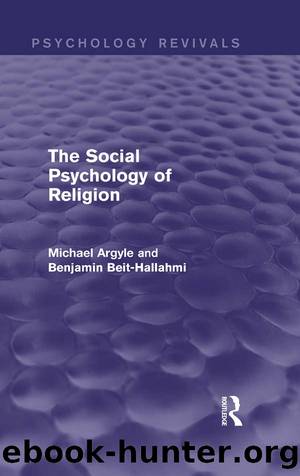The Social Psychology of Religion (Psychology Revivals) by Argyle Michael;Beit-Hallahmi Benjamin;

Author:Argyle, Michael;Beit-Hallahmi, Benjamin;
Language: eng
Format: epub
ISBN: 1569854
Publisher: Taylor & Francis Group
The results of the studies by Stark (1971) and by Srole et al. (1962) can be interpreted in terms of what psychiatric impairment involves for individual functioning, and the relationship of psychiatric impairment to social participation. It is quite clear that psychiatrically impaired individuals, especially those who are labelled âmental patients', are likely to deviate from social norms in many areas; this is how they get the label. Since some religious participation is normative in American culture, it is no wonder that those who deviate from normal behaviour should deviate in this area as well. The data in Table 8.3 could be interpreted as showing that âmental patientsâ are unconventional, as might be expected.
Since public religious activities are social activities, and involve social interaction, they demand a certain level of interpersonal skills and personal adequacy. We should predict that persons who are lacking in social skills would be less likely to participate in social groups. This is indeed the case. Lindenthal et al. (1970) found that psychologically impaired persons were less likely to go to church, and less likely to belong to other social organizations. On the other hand, they were much more likely to pray in private.
Another aspect of formal religious participation, by its social nature, is that the participating individual is offered support and companionship, which in turn may enhance his level of social functioning.
TABLE 8.4 Scores on an index of adjustment, and church membership Church leaders Other church members Non-church members
Married 15 15 12
Widowed 15 11 7
Single 12 8 5
65â70 18 14 10
71â79 15 12 7
80+ 13 8 6
Fully employed 18 18 17
Partly employed 16 16 13
Fully retired 15 12 7
Health (self-rated)
Excellent 17 14 13
Good 15 14 11
Fair 17 6 8
More active in religious organizations than in fifties 16 13 9
Less active 14 11 7
Source: Moberg and Taves (1965).
There is one section of the population for whom there is a clear relation between religion and adjustment: the elderly. In one of the most extensive studies of this group, Moberg and Taves (1965) carried out a survey of 5,000 people of 60 and over, using a series of questions dealing with âhappiness, enjoyment, or satisfaction with or from health, friendships, employment status, religion, feelings of usefulness, family, and general orientation towards, or happiness in, the later years of lifeâ (see Table 8.4). Church leaders and members were significantly better adjusted, within nearly all sub-groups analysed. While religion made a difference within most sub-groups, the difference was greatest for the widowed and single, those in homes, the fully retired, and those in poor health. There was no significant difference for those still in full employment. This suggests that it is either the social support, or the provision of something to do, that has the therapeutic effect.
A number of other studies have obtained similar results. For example, Acuff and Gorman (1967) reported that retired professors who were active religiously showed a better degree of adjustment and less demoralization following retirement, as compared with a control group. The studies reviewed earlier,
Download
This site does not store any files on its server. We only index and link to content provided by other sites. Please contact the content providers to delete copyright contents if any and email us, we'll remove relevant links or contents immediately.
Professional Troublemaker by Luvvie Ajayi Jones(29425)
Empire of the Sikhs by Patwant Singh(22772)
Twilight of the Idols With the Antichrist and Ecce Homo by Friedrich Nietzsche(18303)
Plagued by Fire by Paul Hendrickson(17117)
The Sun and Her Flowers by Rupi Kaur(14330)
Norse Mythology by Gaiman Neil(12846)
A Journey Through Charms and Defence Against the Dark Arts (Harry Potter: A Journey Throughâ¦) by Pottermore Publishing(9141)
Fangirl by Rainbow Rowell(8794)
Adultolescence by Gabbie Hanna(8593)
Wonder by R.J. Palacio(8271)
How to Bang a Billionaire by Alexis Hall(7938)
Becoming Supernatural by Dr. Joe Dispenza(7843)
Tools of Titans by Timothy Ferriss(7822)
Wonder by R. J. Palacio(7746)
Crystal Healing for Women by Mariah K. Lyons(7715)
The Road Less Traveled by M. Scott Peck(7284)
The Lost Art of Listening by Michael P. Nichols(7169)
The Witchcraft of Salem Village by Shirley Jackson(7042)
The Institute by Stephen King(6807)
